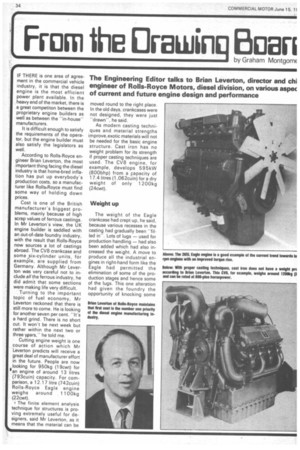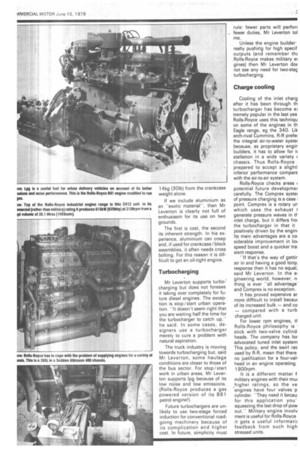The Engineering Editor talks to Brian Leverton, director and chi
Page 36

Page 37

If you've noticed an error in this article please click here to report it so we can fix it.
engineer of Rolls-Royce Motors, diesel division, on various aspec of current and future engine design and performance
IF THERE is one area of agreement in the commercial vehicle industry, it is that the diesel engine is the most efficient power plant available. In the heavy end of the market, there is a great competiton between the proprietary engine builders as well as between the "in-house" manufacturers.
It is difficult enough to satisfy the requirements of the operator, but the engine builder must also satisfy the legislators as well.
According to Rolls-Royce engineer Brian Leverton, the most important thing facing the diesel industry is that home-bred inflation has put up everybody's production costs, so a manufacturer like Rolls,Royce must find some way of holding down prices.
Cost is one of the British manufacturer's biggest problems, mainly because of high scrap values of ferrous castings. In Mr Leverton's view, the UK engine builder is saddled with an out-of-date foundry industry, with the result that Rolls-Royce now sources a lot of castings abroad. The CV8 crankcase and some .six-cylinder units, for example, are supplied from Germany. Although Mr Leverton was very careful not to include a// the ferrous industry, he did admit that some sections were making life very difficult.
Turning to the important topic of fuel economy, Mr Leverton reckoned that there is still more to come. He is looking for another seven per cent. "It's a hard grind. There is no short cut. It won't be next week but rather within the next two or three years," he told me.
Cutting engine weight is one course of action which Mr Leverton predicts will receive a great deal of manufacturer effort in the future. People are now looking for 950kg (19cwt) for an engine of around 13 litres (793cuin) capacity. For comparison, a 12.17 litre (742cuin) Rolls-Royce Eagle engine weighs around 1100kg (22cwt).
t. The finite element analysis technique for structures is proving extremely useful for designers, said Mr Leverton, as it
to means that the material can be
moved round to the right place. In the old days, crankcases were not designed, they were just 'drawn'', he said.
As modern casting techniques and material strengths improve,exotic materials will not be needed for the basic engine structure. Cast iron has no weight problem for its strength if proper casting techniques are used. The CV8 engine, for example, develops 595kW (800bhp) from a capacity of 17.4 litres (1,062cuin) for a dry • weight of only 1200kg (24cwt).
Weight up
The weight of the Eagle crankcase had crept up, he said, because various recesses in the casting had gradually been "filled in". Lots of lugs — used for production handling — had also been added which had also increased the we:ght. A move to produce all the industrial engines in right-hand form like the Eagle had permitted the elimination of some of the production stages and hence some of the lugs. This one alteration had given the foundry the opportunity of knocking some 14kg (30Ib) from the crankcase weight alone.
If we include aluminium as an -exotic material", then Mr Leverton is clearly not full of enthusiasm for its use on two grounds.
The first is cost, the second its inherent strength. In his experience, aluminium can creep and, if used for crankcase/block assemblies, it often needs cross bolting. For this reason it is difficult to get an oil-tight engine.
Turbocharging
Mr Leverton supports turbo: charging but does not foresee it taking over completely for future diesel engines. The exception is stop/start urban operation. "It doesn't seem right that you are waiting half the time for the turbocharger to catch up," he said. In some cases, designers use a turbocharger merely to cure a problem with natural aspiration.
The truck industry is moving towards turbocharging but, said Mr Leverton, some haulage conditions are closer to those of the bus sector. For stop/start work in urban areas, Mr Leverton supports lpg because of its low noise and low emissions. (Rolls-Royce produces a gas powered version of its B81 petrol engine!).
Future turbochargers are unlikely to use two-stage forced induction for conventional roadgoing machinery because of its complication and higher cost. In future, simplicity must rule: fewer parts will perfori fewer duties, Mr Leverton tol me.
Unless the engine builder really pushirig for high specif outputs (and remember thu Rolls-Royce makes military ei gines) then Mr Leverton doE not see any need for two-stac, turbocharging.
Charge cooling
Cooling of the inlet charg after it has been through th turbocharger has become e: tremely popular in the last yea Rolls-Royce uses this techniqu on some of the engines in th Eagle range, eg the 340. Ilk arch-rival Cummins, R-R prefei the integral air-to-water systei because, as proprietary engir builders, it has to allow for ii stallation in a wide variety ( chassis. Thus Rolls-Royce prepared to accept a slight! inferior performance compare with the air-to-air system.
Rolls-Royce checks areas potential future developmel carefully. The Comprex systei of pressure charging is a case point. Comprex is a rotary ur which uses the exhaust generate pressure waves in tl. inlet charge, but it differs fro: the turbocharger in that it positively driven by the engin Its main advantages are a co siderable improvement in lo% speed boost and a quicker tra sient response.
-If that's the way of gettir air in and having a good torqi. response then it has no equal, said Mr Leverton. In the ei gineering world, however, n thing is ever "all advantage' and Comprex is no exception.
It has proved expensive ar more difficult to install becau: of its increased bulk — and co — compared with a turb charged unit.
For lower rpm engines, tt Rolls-Royce philosophy is stick with two-valve cylind heads. The company has lor advocated tuned inlet system This policy, and the swirl rat+ used by R-R, mean that there no justification for a four-vali head in an engine operating 1 90Orpm.
It is a different matter f military engines with their mu(
,higher ratings, so the ve engines have four valves p
cylinder. "They need it becau for this application you' squeezing the last drop of pow out." Military engine involv ment is useful for Rolls-Royce it gets a useful informatiE feedback from such high stressed units.




























































































































